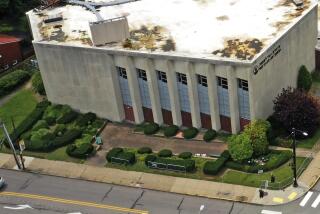At ground zero, 9/11 museum dedicated with somber memories, tears
Florence Jones went to work on Sept. 11, 2001, wearing a pair of black, high-heeled Kenneth Cole shoes.
“I did not plan on walking down 77 flights of stairs,” Jones said Thursday in brief, poignant comments at the dedication of the 9/11 Memorial Museum, where her shoes now are on display.
President Obama, the governors of New York and New Jersey, the city’s present and former mayors and scores of survivors and victims’ relatives attended a dedication ceremony in a room dominated by a steel column that once formed part of the World Trade Center.
The 36-foot-tall chunk, known as the Last Column, was one of the final pieces retrieved from the rubble after hijackers flew planes into the north and south towers, bringing them to the ground. It is one of thousands of exhibits, some massive, some tiny, collected for the 110,000-square-foot museum, which will be open to the public on May 21.
“Those we lost live on in us,” Obama said in a ceremony that steered clear of politics and focused on the acts of people who died saving others, and of those who survived against all odds.
Obama spoke of a mysterious young man in a red bandanna, whom survivors recalled in the days after Sept. 11. The man rushed up and down countless flights of stairs to guide people to safety, until the moment when the towers came down and buried him.
“They didn’t know his name. They didn’t know where he came from. But they knew their lives had been saved by the man in the red bandanna,” said Obama, who went on to introduce Alison Crowther, the mother of the man: Welles Crowther.
“For us, he lives on,” Crowther said of her son, who was 24 and who had a habit of always wearing a red bandanna. One of Welles Crowther’s bandannas is now on display in the museum.
His mother was joined on stage by Ling Young, one of the people Welles Crowther led to safety.
“I’m here today because of Welles,” Young said of Crowther, who worked on the 104th floor of one of the towers, and who had been a volunteer firefighter.
Jones had worked on the 77th floor. She described pulling off her shoes as she walked in stocking feet down the steps, and then walking 50 more blocks -- still barefoot -- to a friend’s office.
Jones put the shoes into a plastic container. Then, she heard the museum organizers were looking for items to display.
“I thought about my shoes,” she said. “And when I took them out, they still had the smell on them from that awful day.”
Jones said she knew at that moment that she never would wear the shoes again, but she wanted others to see them, and “maybe understand what it felt like to be us on that day.”
The museum, more than a decade in the making, was slowed by disputes that underscored the challenge of bringing together victims’ families, politicians, civil leaders, and developers in a project that seeks to combine solemn remembrance with a harsh history lesson.
“It is a witness to tragedy,” said former Mayor Michael R. Bloomberg, chairman of the board of the nonprofit foundation overseeing the 9/11 Memorial and Museum. “It is an affirmation of human life. It is a reminder to us … that freedom carries heavy responsibilities.”
But those speaking at the ceremony said they hoped the museum, while detailing the rise of Al Qaeda and the loss of nearly 3,000 human lives on Sept. 11, 2001, and in the 1993 World Trade Center bombing, would send a message of resilience.
Many spoke of the outpouring of good will toward New York that followed the attacks, and of the acts of heroism, such as Welles Crowther’s, the young man in the red bandanna.
“That is the true legacy of Sept. 11,” his mother said.
More to Read
Start your day right
Sign up for Essential California for news, features and recommendations from the L.A. Times and beyond in your inbox six days a week.
You may occasionally receive promotional content from the Los Angeles Times.








